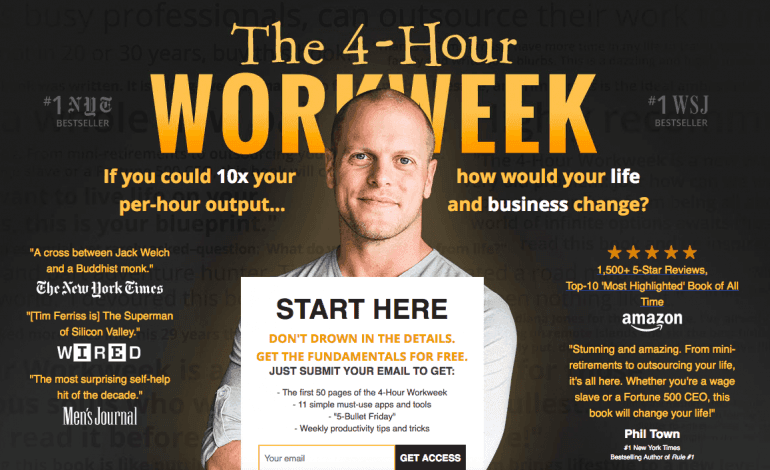How I Implemented The 4-Hour Workweek Methodology And Doubled My Results
timedoctor.com
10 ideas
·1.6K reads
10
Learn more about productivity with this collection
How to prioritize self-care in the workplace
How to adapt to new work arrangements
How to maintain work-life balance
Introduction - What is Possible?
- Imagine one thing for a minute: a working week of only four hours. Don’t worry; the idea is that you’d still be making enough money. You’ll be working less, but you’ll be more productive.
- What would you do with the time you have left? Movies. A book. Maintaining friendships and family values. Every day would be like a mini vacation if you followed the 4-hour workweek.
- Timothy Ferriss, an American author and entrepreneur, says that is possible. His book, The 4-Hour Workweek: Escape 9-5, Live Anywhere, and Join the New Rich, changed many people’s lives.
- In its basis, The 4-Hour Workweek is a productivity concept. The author himself tested it. He went from making $40,000 per year on an 80-hour workweek to making $40,000 per month on a 4-hour workweek.
- When I read the book, I realized it was more realistic and actionable than I expected.
65
169 reads
Brief Explanation on the Concept of the 4-Hour Workweek
- If you think about it, you surely know someone who owns a company and is absolutely consumed by it.
- Tim Ferriss is convincing entrepreneurs that there’s a better way to live: work less and make more money.
- I find that this book is not only the Bible of entrepreneurs, but it’s also the Bible of remote workers.
59
184 reads
D. E. A. L
- According to Tim Ferriss, we should make four major steps to make the transition towards the 4-hour workweek.
- DEAL is the name of this system, meaning Definition, Elimination, Automation, and Liberation.
65
220 reads
1. Definition
Define your goal in this life and estimate its cost. In this stage, you will envision the fundamentals of your entirely new lifestyle. Then, you’ll add the remaining three ingredients.
62
193 reads
2. Elimination
- What do you need to eliminate? Your old mindset about time management.
- Once you define your goal and you understand how much money you need to make it happen, you’ll find the source of that income. The source won’t be the work in the office.
- Remember: your goal is not building a multimillion-dollar empire. It’s about living a stress-free life that lets you experience the most of it.
64
171 reads
2. Elimination (cont.)
- Ferriss recommends techniques for cultivating selective ignorance.
- You won’t be spending time on processing information you don’t need.
- You’ll start ignoring things that are not important.
- You’ll learn how to value your time .
- Experts also recommend that changing one’s morning drill can improve your day’s productivity.
- By following an efficient routine in the morning, it can help save entrepreneurs and remote workers more hours.
63
135 reads
3. Automation
- For this part, the author teaches you how to put cash flow on autopilot.
- Implementing the previous two steps should provide you with a stable income and tons of free time.
- What do you do with it? In other words, you get to the tricky What’s Next? stage.
- Tim Ferriss suggests traveling.
60
137 reads
4. Liberation
- “The mobile manifesto for the globally inclined” – that’s how Tim Ferriss defines liberation.
- He suggests a concept of mini retirements.
- The lifestyle of mobility is not about cheap travel. That can get boring.
- The author recommends you to start thinking about more important things, such as the purpose you have in this life and the value you can bring to other people.
60
117 reads
5. The Pareto Principle (80/20)
- According to the Pareto Principle, recommended by Tim Ferriss himself, roughly 20% of your efforts result with roughly 80% of the effects.
- By doing 20% of the work you’re doing now (of course, you’ll wisely choose those 20%), you’ll achieve 80% of the results you’re reaching at the moment.
59
138 reads
6. The Low-Information Diet
- This is another important aspect of the decluttering process.
- Ferriss recommends making the task lists that keep you on track and create a distraction-blocking mindset.
- He also asks us to set limits on the information we process. If I need to read information about hurricane Irma, I’ll do it after my work is done and I’ll do it at one go. I will not check the news 50 times today, reading the same thing from dozens of different sources.
59
145 reads
CURATED BY
Lawyer turned Artist Visionary Curator & Gallerist. Empowering self-love and joy through art & words. www.innerjoyart.com 💝 Instagram : dymphna.art
More like this
11 ideas
The 4-Hour Workweek
Timothy Ferriss
2 ideas
How one hour of slow breathing changed my life
theguardian.com
5 ideas
Tim Ferriss Quotes to SPARK Action Today
medium.com
Read & Learn
20x Faster
without
deepstash
with
deepstash
with
deepstash
Access to 200,000+ ideas
—
Access to the mobile app
—
Unlimited idea saving & library
—
—
Unlimited history
—
—
Unlimited listening to ideas
—
—
Downloading & offline access
—
—
Personalized recommendations
—
—
Supercharge your mind with one idea per day
Enter your email and spend 1 minute every day to learn something new.
I agree to receive email updates









